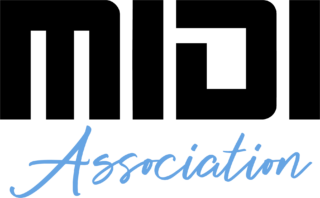 At the 2022 NAMM Show – being held June 3-5, 2022 in Anaheim, California – the MIDI Association announced the addition of MIDI 2.0 capabilities to the Automotive Audio Bus (A2B) from Analog Devices, Inc.
At the 2022 NAMM Show – being held June 3-5, 2022 in Anaheim, California – the MIDI Association announced the addition of MIDI 2.0 capabilities to the Automotive Audio Bus (A2B) from Analog Devices, Inc.
A2B is a high bandwidth, bidirectional, digital audio bus capable of distributing 32 channels of audio and MIDI control data, together with clock and power over a single, unshielded twisted-pair wire.
The technology is designed for advanced audio and MIDI LAN systems for automobiles, smart homes and pro audio applications.
A2B will support both MIDI 1.0 and MIDI 2.0 devices and provide backward compatibility/translation, where necessary.
“We see many opportunities for the extension of Analog Device’s A2B into musical instrument and pro audio applications, particularly for guitar effects, electronic drums, digital keyboards and small format audio mixers,” said David Dashefsky, Director for Strategic Marketing and Systems in the Consumer Business Unit at Analog Devices. “MIDI 2.0 and ADI’s A2B digital audio bus now allow your whole band to connect together with multi-channel digital audio over low-cost cables, or inexpensively connect modular systems like guitar pedals or electronic drum kits”
“Combining the multi-channel audio networking capabilities of the Analog Devices A2B with MIDI’s expressive musical control creates a brand-new technology platform for the musical instrument and pro audio industry,” said Athan Billias, President of the MIDI Association. “This inexpensive platform to connect multiple digital instruments together is a big boon to designers of musical instrument and pro audio applications.”

Single twisted pair? Pretty amazing.
great, another proprietary connector?
Midi 2.0 again? again?
I think the 2020 announcement was the soft launch. Now it’s the full launch.
ahh the hard launch. couldn’t help myself
couldn’t help myself
MIDI 2.0 is an ambitious expansion of the things we can do with MIDI, and the MIDI 2.0 spec describes data and protocols for it.
A2B is not equal to MIDI 2.0. It is a new connection format that combines 32 channels of audio along with MIDI 2.0 (and MIDI 1.0).
The fact that they could possibly keep cables and the connections cheap is excellent news.
A person could route serious audio & MIDI between synth/fx/recording/etc devices and make very complex and integrated sound-paths between/among them– like many inserts, sends, returns, parallel paths, plus many lanes of high-res modulation etc.
Personally I don’t understand why the MIDI association don’t push harder for MIDI2 over Ethernet AKA rtpmidi. Cheap cabling, very standardized ecosystem, very high speed and low latency.
Is there any negative side I don’t see?
So i’ll have Midi 2.0 in my car before i have it in my studio?
This is about the wire, not the spec. But seriously, let’s hope all the music manufacturers get on board before the car companies do.
Very likely, because ios and android are ahead of implementing midi 2.0.
UMP.
Something else ‘hack RF’ will be able to mess with.
If not shielded what is the transmission distance, 100m for Dante over shielded? Also why would you use an unshielded system in an automotive industry that uses so many wireless signals, seems to be asking for trouble?
The twist on differential pairs acts a a sort of shield and shields are expensive.